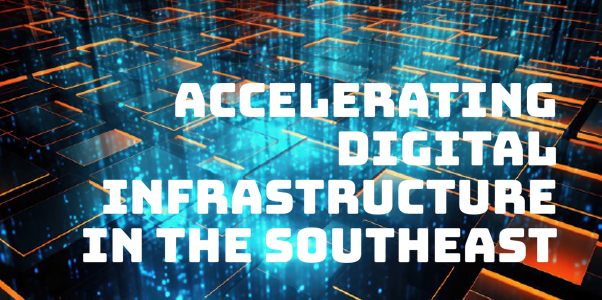
By Melissa Reali Elliott
The Southeast United States is quickly becoming a point of interest for digital infrastructure builders with an eye for future development. As demonstrated by their explosive population growth, many cities up the East coast are known for their exceptional economic climate and superior quality of life, combined with a dynamic, educated workforce and abundant resources. As businesses invest to grow their Southeast operations, there is a growing need to accelerate digital infrastructure. By tuning in to digital trends, digital operators, especially hyperscalers, are quick to identify emerging needs in order to stay ahead of shifting markets, bringing fresh infrastructure support for more business growth.
NO MAN IS AN ISLAND
The complexity to add new interconnected “nodes,” increase bandwidth, reduce latency, and optimize network connectivity, means that data center operators are continuously searching for more capacity and additional routes to connect sites to the growing global ecosystem of digital providers. Future demands continue to emerge and evolve, accelerating the need for integrated digital infrastructure solutions that are interwoven to create a “fabric” of connectivity.
More than ever, data centers must provide connectivity for its services and to other operators. This means expanding access to and from their customers in all directions, in turn allowing them to provide service to any location, regardless of whether it’s available in their own facility. By adding routes and access points to accommodate more service capabilities, digital integrators are building alternative pathways. The emphasis must be on fortifying this market to be able to provide digital enablement of any kind, which, given the rapid adoption of revolutionary technologies, such as AI, can change within months.
INTERCONNECTION HAS BECOME A LEAD DIFFERENTIATOR
Interconnection holds immense significance for network operators and service providers due to its pivotal role in seamless communication and expanding reach. It empowers companies to extend their network coverage, reach new markets, and provide enhanced service offerings. Data centers in the Southeast with access to subsea cables and the newly constructed Myrtle Beach CLS will be a step ahead of the game, able to plug in to the interconnected global fabric that will contribute to network resiliency, increased access to global communications partners, and the engagement of international markets.
When looking at the traffic that will be generated from subsea cable operators, being able to connect to cloud and content service providers will play a crucial role in meeting the needs of the region. This can be achieved through developing a host of unique fiber routes to bolster regional connectivity and streamline operations. An expansion of diverse fiber routes also ensures that a business is protected from downtime due to man-made or natural disasters.
A customer should be able to go to any data center and have access to a broad connectivity ecosystem and a full stack of services all in one place. Data centers primed for the growth of activity must learn to interweave resilient and reliable colocation with international and regional connectivity to create a fabric of support and accelerate the digital infrastructure needs that are looming on the horizon.
HERE ENTERS THE NEED FOR MORE CABLE LANDING STATIONS
Building full digital integration to serve our ever-growing needs for connectivity, means we must prime regions by building new accessibility to the subsea cable network. Access to international markets through a cable landing station gives network operators a more comprehensive way to serve the entire region and fortifies opportunities for those that rely on digital infrastructure. According to TeleGeography, there are over 550 active and planned submarine cables currently underway around the world. Fiber-optic cables originating from the Southeastern coastline have the capability to extend to Europe, South America, and Africa.
The Southeast region is being brought up to par with leading international markets, making it a focal point in the future of digital infrastructure. Having access points for international connectivity increases the viability of multi-state — and beyond that, multimarket — reach in that area. With the example of our CLS in South Carolina, this new development removes the burden of routing through other more distant states like Florida for subsea connectivity.
As our increasingly digital world grows and global connectivity correspondingly accelerates, terrestrial network operators must start tackling what the next-generation of digital infrastructure will look like. The goal must be to think one step ahead.Interconnected regions, like what DC BLOX is building in the Southeast, are preparing to serve as leading gateways for global businesses across continents. With this new data neural network, the coming years will see a boom of business that connects operationsand opportunities from around the world together through vertically-integrated digital infrastructure.
Melissa Reali Elliott is Content Marketing Manager at DC BLOX. She can be reached at dcblox@imillerpr.com.